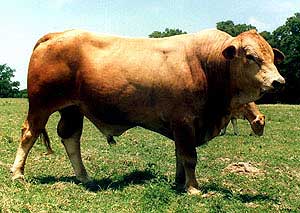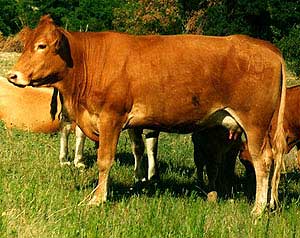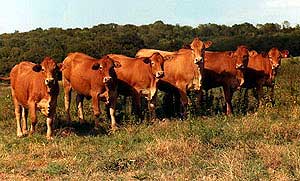Gelbray Cattle
 The 1960's was the golden era for purebred cattle breeding in the United States. It
was a time when large numbers of cattle were recorded in breed registries.
The 1960's was the golden era for purebred cattle breeding in the United States. It
was a time when large numbers of cattle were recorded in breed registries.
Then came the 70's and 80's when European Cattle or exotics were introduced to purebred breeders. Elaborate facilities and high priced cattle sales were signs of the times. These were cattle with funny names and multiple colors from the shores of Europe. Simmental, Limousin, Gelbvieh, Maine Anjou, Chianina and others were becoming common breeds in our pastures.
The beef cattle industry is now in an era of biotechnology. Revolutionary changes are taking place and many new ideas are being presented. The 1990's will be known as the era of Composites. The increased competition for market share from the hog and poultry industries are forcing us to produce a more efficient and competitive animal.
The role of the cow/calf producer has no changes. The key to the producer's success is basically as it has been in the past:
- Production: a calf every 12 months from each cow
- Weaning weights: as many pounds of calf produced per acre of land as economically practical.
- Cost of production: cost per pounds of calf produced as low as possible while maintaining productivity.
The Gelbray Breed of cattle is in a unique position to capitalize on these traditional goals. The combination of Gelbvieh, Red Angus and Brahman genetics has proven Gelbray to be a maternal breed with the ability to sire slaughter calves suitable for feedlots and packing plants in the United States.
 The most important trait in any breed of Cattle is reproduction. Reproductive performance
is 10 times more important than growth traits and growth traits are five times more
important than carcass traits. We cannot forget that pounds of calf weaned per cow
exposed puts money in the pockets of the commercial cattleman. This point is most
important to breeders and must always be considered.
The most important trait in any breed of Cattle is reproduction. Reproductive performance
is 10 times more important than growth traits and growth traits are five times more
important than carcass traits. We cannot forget that pounds of calf weaned per cow
exposed puts money in the pockets of the commercial cattleman. This point is most
important to breeders and must always be considered.
Calving problems in Beef Cattle are predominately related to breed of dam effect. Thus, Gelbray are able to control the size of their calves simply because the Brahman influence further supports this strong maternal breed. It has also been documented that Brahman (Bos-Indicus) female will typically produce a calf that weighs about 6.5% of her body weight, whereas the Bos-Taurus such as Gelbvieh and Angus cows will produce between 7 to 8% of their body weight in calf birth. Calving ease and maternal traits are of interest to all cattle producers. Unassisted births are the rule - not the exception.
The environment makes raising cattle more difficult in some regions. The southern states find summer heat, insects and other pests are tough on cattle. The northern states find the cold winters and limited forage hard on cattle. That is why producers have utilized composite breeding to develop environmental adaptability and hardiness in the Commercial Beef Industry.
The combination of Gelbvieh, Red Angus and Brahman cattle, with its proven reproductive efficiency and pre-weaning performance, will also perform post-weaning. In addition, Gelbray will produce a carcass that is market acceptable. Its economic traits are:
- Fertility -- Gelbvieh & Red Angus
- Early Puberty -- Gelbvieh
- Calving Ease -- Brahman
- Milk Production & Mothering Ability -- Gelbvieh, Red Angus & Brahman
- Efficiency -- Gelbvieh, Red Angus & Brahman
- Beef Production/ Cutability & Quality -- Gelbvieh & Red Angus
- Uniform Type & Color -- Gelbvieh & Red Angus
- Adaptability/Survivability -- Brahman
Gelbray demonstrates the use of a cross breeding system to maintain heterosis (approximately 67% on a long term breeding program without purchasing outside animals). Animal scientists say three breed composites like Gelbray can retain 67% of the hybrid vigor they generate while other two cross breeds cannot.
The goals of the Gelbray Breed are:
- Keep a Gelbvieh, Red Angus and Brahman composite.
- Maintain reproductive efficiency.
- Maintain 500+ pounds at weaning.
- Maintain a 3+ pound gain in the feedlot.
- Produce calves of acceptable yield grade and carcass quality.
The breeder is allowed maximum flexibility in his matings. In developing a profitable genetic program the best traits for the herd can be selected for a balanced cowherd. The blood percentages for an animal to be registerable as a Gelbray allows breeders in all regions to select cattle that will best perform in their pastures. Those percentages are:
- Maximum 3/4 Gelbvieh -- minimum 1/4 Gelbvieh = Gelbray
- Maximum 1/2 Red Angus -- minimum 0 Red Angus = Gelbray
- Maximum 3/8 Brahman -- minimum 1/8 Brahman = Gelbray
A 3 Generation Pedigree is developed from each mating by the use of registered cattle. It is possible to take advantage of the Gelbray genetic difference through simple and uncomplicated matings. Some examples of one step breeding resulting in a Gelbray could be:
- 100% Gelbvieh x 50% Red Angus x 50% Brahman = Gelbray
- 100% Gelbvieh x 100% Red Brangus = Gelbray
- 100% Gelbray x 50% Gelbvieh x 50% Red Angus = Gelbray
 One breed cannot fit everyone's needs. Neither will a single breed be the answer.
To be successful you must fit your cowherd to your ranch and put a bull on those cows
that will compliment them and produce a highly marketable calf.Gelbray combines the
"right kind" of breed genetics that will allow its breeders to effectively compete
for the "meat dollar". Don't forget ... the animal pedigree tells you what the animal
should be and performance data tells you what the animal is.
One breed cannot fit everyone's needs. Neither will a single breed be the answer.
To be successful you must fit your cowherd to your ranch and put a bull on those cows
that will compliment them and produce a highly marketable calf.Gelbray combines the
"right kind" of breed genetics that will allow its breeders to effectively compete
for the "meat dollar". Don't forget ... the animal pedigree tells you what the animal
should be and performance data tells you what the animal is.
References
Gelbray International, Box 2177, Ardmore, OK 73402
Phone: (580) 223-5771
